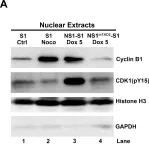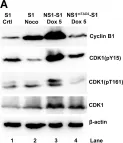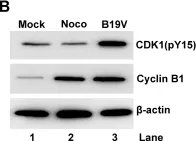Ovarian cancer (OV) has the highest mortality rate among gynecological cancers. As OV progresses, tumor cells spread outside the ovaries to the peritoneal and abdominal cavities, forming cell clusters that float in the ascitic fluid caused by peritonitis carcinomatosa, leading to further dissemination and metastasis. These cell clusters are enriched with cancer stem cells (CSCs) which are responsible for treatment resistance, recurrence, and metastasis. Therefore, targeting CSCs is a potentially effective approach for treating OV. However, understanding how CSCs acquire treatment resistance and identifying targets against CSCs remains challenging. In this study, we demonstrate that 3D-spheroids of OV cell lines exhibit higher stemness than conventional adherent cells. Metabolomics profiling studies have revealed that 3D-spheroids maintain a high-energy state through increased glucose utilization in the citric acid cycle (TCA), efficient nucleotide phosphorylation, and elevated phosphocreatine as an energy buffer. We also found that nicotinamide phosphoribosyltransferase (NAMPT), the rate-limiting enzyme for NAD+ production, is highly expressed in OV. Furthermore, the approach based on NAMPT dependence rather than histology found NAMPT to be a potential therapeutic target against CSCs, while also serving as a prognostic indicator in OV. Moreover, we identified a previously unrecognized anti-tumor mechanism whereby disulfiram, an aldehyde dehydrogenase (ALDH) inhibitor, synergistically inhibited mitochondrial function when combined with NAMPT inhibitors - leading to cell cycle arrest in G2/M. Finally, the combination of a NAMPT inhibitor and disulfiram showed significant anti-tumor effects and extended survival in an animal model. Our findings demonstrate the potential of spheroids as a preclinical model for targeting OV CSCs and also indicate that the combination of NAMPT inhibitors and disulfiram is a promising therapeutic strategy to overcome recurrent OV.
© 2025. This is a U.S. Government work and not under copyright protection in the US; foreign copyright protection may apply.
Product Citations: 12
In Cell Death & Disease on 25 April 2025 by Kudo, K., Greer, Y. E., et al.
-
Biochemistry and Molecular biology
-
Cancer Research
-
Cell Biology
Multiplexed single-cell analysis of organoid signaling networks.
In Nature Protocols on 1 October 2021 by Sufi, J., Qin, X., et al.
Organoids are biomimetic tissue models comprising multiple cell types and cell states. Post-translational modification (PTM) signaling networks control cellular phenotypes and are frequently dysregulated in diseases such as cancer. Although signaling networks vary across cell types, there are limited techniques to study cell type-specific PTMs in heterocellular organoids. Here, we present a multiplexed mass cytometry (MC) protocol for single-cell analysis of PTM signaling and cell states in organoids and organoids co-cultured with fibroblasts and leukocytes. We describe how thiol-reactive organoid barcoding in situ (TOBis) enables 35-plex and 126-plex single-cell comparison of organoid cultures and provide a cytometry by time of flight (CyTOF) signaling analysis pipeline (CyGNAL) for computing cell type-specific PTM signaling networks. The TOBis MC protocol takes ~3 d from organoid fixation to data acquisition and can generate single-cell data for >40 antibodies from millions of cells across 126 organoid cultures in a single MC run.
© 2021. The Author(s), under exclusive licence to Springer Nature Limited.
In Journal of Cellular Physiology on 1 March 2020 by Panda, P. K., Patra, S., et al.
Therapy-induced senescence in cancer cells is an irreversible antiproliferative state, which inhibits tumor growth and is therefore a potent anti-neoplastic mechanism. In this study, low doses of Abrus agglutinin (AGG)-induced senescence through autophagy in prostate carcinoma cells (PC3) and inhibited proliferation. The inhibition of autophagy with 3-methyl adenine reversed AGG-induced senescence, thus confirming that AGG-triggered senescence required autophagy. AGG treatment also led to lipophagy-mediated accumulation of free fatty acids (FFAs), with a concomitant decrease in the number of lipid droplets. Lalistat, a lysosomal acid lipase inhibitor, abrogated AGG-induced lipophagy and senescence in PC3 cells, indicating that lipophagy is essential for AGG-induced senescence. The accumulation of FFAs increased reactive oxygen species generation, a known facilitator of senescence, which was also reduced in the presence of lalistat. Furthermore, AGG upregulated silent mating type information regulator 2 homolog 1 (SIRT1), while the presence of sirtinol reduced autophagy flux and the senescent phenotype in the AGG-treated cells. Mechanistically, AGG-induced cytoplasmic SIRT1 deacetylated a Lys residue on the cytoplasmic domain of lysosome-associated membrane protein 1 (LAMP1), an autolysosomal protein, resulting in lipophagy and senescence. Taken together, our findings demonstrate a novel SIRT1/LAMP1/lipophagy axis mediating AGG-induced senescence in prostate cancer cells.
© 2019 Wiley Periodicals, Inc.
-
Cancer Research
-
Endocrinology and Physiology
A Single-Cell Atlas of the Tumor and Immune Ecosystem of Human Breast Cancer.
In Cell on 16 May 2019 by Wagner, J., Rapsomaniki, M. A., et al.
Breast cancer is a heterogeneous disease. Tumor cells and associated healthy cells form ecosystems that determine disease progression and response to therapy. To characterize features of breast cancer ecosystems and their associations with clinical data, we analyzed 144 human breast tumor and 50 non-tumor tissue samples using mass cytometry. The expression of 73 proteins in 26 million cells was evaluated using tumor and immune cell-centric antibody panels. Tumors displayed individuality in tumor cell composition, including phenotypic abnormalities and phenotype dominance. Relationship analyses between tumor and immune cells revealed characteristics of ecosystems related to immunosuppression and poor prognosis. High frequencies of PD-L1+ tumor-associated macrophages and exhausted T cells were found in high-grade ER+ and ER- tumors. This large-scale, single-cell atlas deepens our understanding of breast tumor ecosystems and suggests that ecosystem-based patient classification will facilitate identification of individuals for precision medicine approaches targeting the tumor and its immunoenvironment.
Copyright © 2019 The Authors. Published by Elsevier Inc. All rights reserved.
-
CyTOF
-
Homo sapiens (Human)
-
Cancer Research
-
Immunology and Microbiology
In Oncology Letters on 1 June 2017 by Jin, X., Fang, Y., et al.
Although a combination of platinum- and taxane-based chemotherapy is recommended for at least 70% patients with ovarian cancer as treatment subsequent to surgery, the initial response to the chemotherapy is not durable and tumors become resistant. Histone deacetylase and proteasome inhibitors are novel therapeutic agents. However, the moderate antitumoral effect of the inhibitors has restricted their clinical use when used as single agents. The aim of the present study was to investigate the synergistic activity of trichostatin A (TSA) and PS-341 in ovarian cancer cells, along with the investigation of the molecular mechanisms of taxane resistance. The taxane-sensitive ovarian cancer A2780 cell line and its resistant variant, A2780T, were treated with taxane, TSA and PS-341 at various concentrations. An Annexin V assay was performed to determine the levels of cell viability and apoptosis, while flow cytometry and immunofluorescence staining for the mitotic phase-specific protein phosphorylated-histone H3 (Ser10) were used for cell cycle detection. The effects of combined TSA and PS-341 on cell cycle-associated proteins were tested by western blot analysis. Furthermore, the present study examined the apoptosis and cell cycle arrest induced by the 3 agents subsequent to overexpression or downregulation of cyclin B1 in A2780 and A2780T cells, respectively. It was found that TSA interacted synergistically with PS-341, resulting in a marked increase in apoptosis and the rate of G2/M arrest in A2780T cells. A lower basal level of cyclin B1 expression and the incompetence of the upregulation of the cyclin may explain the taxane resistance found in A2780T cells. Collectively, the combination of TSA and PS-341 increased cyclin B1 expression level regardless of the basal expression level, resulting in the proliferation inhibition and apoptosis in A2780 and A2780T cells, which raised the possibility that a combination of the two drugs may represent a novel strategy for the treatment of ovarian cancer, particularly in taxane-resistant ovarian cancer.
-
Homo sapiens (Human)
-
Cancer Research
-
Genetics
In PLoS Pathog on 1 March 2017 by Xu, P., Zhou, Z., et al.
Fig.4.A

-
WB
-
Homo sapiens (Human)
Collected and cropped from PLoS Pathog by CiteAb, provided under a CC-BY license
Image 1 of 4
In PLoS Pathog on 1 March 2017 by Xu, P., Zhou, Z., et al.
Fig.3.A

-
WB
-
Homo sapiens (Human)
Collected and cropped from PLoS Pathog by CiteAb, provided under a CC-BY license
Image 1 of 4
In PLoS Pathog on 1 March 2017 by Xu, P., Zhou, Z., et al.
Fig.8.E

-
WB
-
Homo sapiens (Human)
Collected and cropped from PLoS Pathog by CiteAb, provided under a CC-BY license
Image 1 of 4
In PLoS Pathog on 1 March 2017 by Xu, P., Zhou, Z., et al.
Fig.10.B

-
WB
-
Homo sapiens (Human)
Collected and cropped from PLoS Pathog by CiteAb, provided under a CC-BY license
Image 1 of 4



